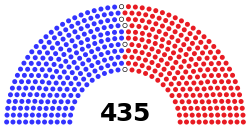
Back Amerikaanse Huis van Verteenwoordigers Afrikaans Repräsentantenhaus der Vereinigten Staaten ALS Speliendena Hūs þāra Geānedan Rīca American ANG مجلس النواب الأمريكي Arabic مجلس نواب امريكا ARZ Cámara de Representantes de los Estaos Xuníos AST ABŞ Nümayəndələr Palatası Azerbaijani United States House of Representatives BAR Палата Прадстаўнікоў ЗША Byelorussian Палата прадстаўнікоў ЗША BE-X-OLD
United States House of Representatives | |
|---|---|
| 118th United States Congress | |
 Seal of the House | |
 Flag of the United States House of Representatives | |
| Type | |
| Type | |
Term limits | None |
| History | |
New session started | January 3, 2023 |
| Leadership | |
| Structure | |
| Seats | 435 voting members 6 non-voting members 218 for a majority |
 | |
Political groups | Majority (220)
Minority (213)
Vacant (2)
|
Length of term | 2 years |
| Elections | |
| Plurality voting in 46 states[a] Varies in 4 states | |
Last election | November 5, 2024 |
Next election | November 3, 2026 |
| Redistricting | State legislatures or redistricting commissions, varies by state |
| Meeting place | |
 | |
| House of Representatives Chamber United States Capitol Washington, D.C. United States of America | |
| Website | |
| house | |
| Rules | |
| Rules of the House of Representatives | |
| This article is part of a series on the |
| Politics of the United States |
|---|
 |
The United States House of Representatives is the lower chamber of the United States Congress, with the Senate being the upper chamber. Together, they compose the national bicameral legislature of the United States.[1][2] The House is charged with the passage of federal legislation, known as bills; those that are also passed by the Senate are sent to the president for signature or veto. The House's exclusive powers include initiating all revenue bills, impeaching federal officers, and electing the president if no candidate receives a majority of votes in the Electoral College.[3][4]
Members of the House serve a fixed term of two years, with each seat up for election before the start of the next Congress. Special elections also occur when a seat is vacated early enough. The House's composition was established by Article One of the United States Constitution. The House is composed of representatives who, pursuant to the Uniform Congressional District Act, sit in single member congressional districts allocated to each state on the basis of population as measured by the United States census, with each district having at least a single representative, provided that that state is entitled to them.[5] Since its inception in 1789, all representatives have been directly elected. Although suffrage was initially limited, it gradually widened, particularly after the ratification of the Nineteenth Amendment and the civil rights movement. Since 1913, the number of voting representatives has been at 435 pursuant to the Apportionment Act of 1911.[6] The Reapportionment Act of 1929 capped the size of the House at 435. However, the number was temporarily increased from 1959 until 1963 to 437 following the admissions of Alaska and Hawaii to the Union.[7]
In addition, five non-voting delegates represent the District of Columbia and the U.S. territories of Guam, the U.S. Virgin Islands, the Commonwealth of the Northern Mariana Islands, and American Samoa. A non-voting Resident Commissioner, serving a four-year term, represents the Commonwealth of Puerto Rico. As of the 2020 census, the largest delegation was California, with 52 representatives. Six states have only one representative apiece: Alaska, Delaware, North Dakota, South Dakota, Vermont, and Wyoming.[8]
The House meets in the south wing of the United States Capitol. The rules of the House generally address a two-party system, with a majority party in government, and a minority party in opposition. The presiding officer is the Speaker of the House, who is elected by the members thereof. Other floor leaders are chosen by the Democratic Caucus or the Republican Conference, depending on whichever party has the most voting members.
Cite error: There are <ref group=lower-alpha> tags or {{efn}} templates on this page, but the references will not show without a {{reflist|group=lower-alpha}} template or {{notelist}} template (see the help page).
- ^ "The House Explained". house.gov. Archived from the original on December 3, 2023. Retrieved December 3, 2023.
- ^ "House of Representatives | Definition, History, & Facts". Britannica. December 2, 2023. Retrieved December 3, 2023.
- ^ Article 1, Section 7 of the Constitution
- ^ Article 1, Section 2, and in the Twelfth Amendment to the United States Constitution
- ^ Bureau, US Census. "About Congressional Apportionment". Census.gov. Retrieved December 3, 2023.
{{cite web}}:|last=has generic name (help) - ^ See Public Law 62-5 of 1911, though Congress has the authority to change that number.
- ^ "Explainer: Why Does The U.S. House Have 435 Members?". NPR. April 20, 2021. Archived from the original on March 29, 2022. Retrieved April 1, 2022.
- ^ United States House of Representatives Archived June 24, 2018, at the Wayback Machine, Ballotpedia. Accessed November 23, 2016. "There are six states with only one representative: Alaska, Delaware, North Dakota, South Dakota, Vermont and Wyoming."